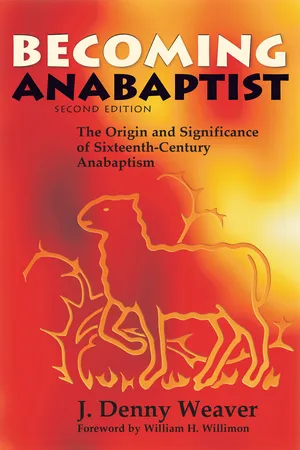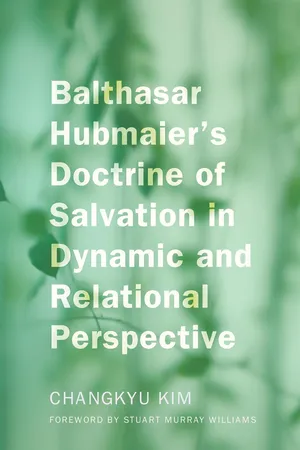History
Anabaptism
Anabaptism was a radical Christian movement that emerged during the 16th-century Protestant Reformation. Anabaptists rejected infant baptism and instead advocated for adult baptism, emphasizing personal faith and voluntary church membership. They also promoted the separation of church and state, nonviolence, and communal living. Anabaptism had a significant impact on the development of religious and political thought in Europe.
Written by Perlego with AI-assistance
Related key terms
1 of 5
10 Key excerpts on "Anabaptism"
- eBook - PDF
Profiles of Anabaptist Women
Sixteenth-Century Reforming Pioneers
- C. Arnold Snyder, Linda A. Huebert Hecht, C. Arnold Snyder, Linda A. Huebert Hecht(Authors)
- 2006(Publication Date)
- Wilfrid Laurier University Press(Publisher)
But Anabaptism soon was outlawed in the Holy Roman Empire, and virtually all western European states and territories followed suit. Anabaptism emerged as a distinct church reforming movement when its adherents insisted upon adult baptism following individual confession of faith. Opponents attached the label of Anabaptists [in German, Wiedertdufer] to adherents of the baptizing movement. The label literally meant rebaptizers, since those who practised adult baptism already had been baptized once, as infants, into the Catholic communion; but the word also carried connotations of fanaticism, heresy, civil disobedience, and sedition. Of course, the rebaptizers rejected the label; they insisted that the infant bath they had received as unknowing children was no baptism at all. They were not rebaptizers, they said, but believed in only one, true baptism-their freely chosen adult baptism. In spite of these disclaimers, the reproachful name Anabaptist stuck; it remains the best historical term to describe a widespread, diverse reform movement that managed to survive in 2 Profiles of Anabaptist Women spite of systematic persecution. Direct descendants of the Anabaptists are present-day Mennonites, Hutterites, Amish, and some groups of Brethren, such as the Mennonite Brethren, the Church of the Brethren and the Brethren in Christ; the present-day Baptist denominations also can claim significant roots in the Anabaptist movement of the sixteenth century. Modern historical studies of Anabaptism have identified a diversity of historical origins, teachings, and practices among Anabaptist groups. The most widely accepted historical description of sixteenth-century Anabaptism now speaks of the polygenetic origins of Anabaptism. The origins of three primary Anabaptist groups have been identified and described in some detail: Swiss Anabaptism, South German/Austrian Anabaptism, and North German/Dutch Anabaptism. - eBook - ePub
Winds of the Spirit
A Profile of Anabaptist Churches in the Global South
- Conrad Kanagy, Tilahun Beyene, Richard Showalter(Authors)
- 2012(Publication Date)
- Herald Press(Publisher)
8
Anabaptism from Sixteenth-Century Europe to the Twenty -First-Century Global South
Perishing communities (and ideas) produce historians and sociologists and academic conferences. Flourishing communities produce preachers, missionaries, and prayer meetings. Right now the Anabaptist Vision is producing lots of the former, few of the latter. Unless there is some way to put Pentecost into the Anabaptist Vision its creative role in the Mennonite churches is exhausted.1 —Stephen Dintaman, Mennonite theologianAnabaptism represents the believers church movement of the European Protestant Reformation, with origins in the early sixteenth century—just a few years after Luther nailed his ninety-five theses to the Wittenberg church door.2 Early Anabaptists are sometimes referred to as “Radical Reformers” and their movement as the “third way” of the Protestant Reformation. Also identified as a “believers church” because they baptized adult believers, these followers of Jesus were radical because they wanted not simply to reform the church but rather to restore it to a New Testament simplicity. They were a third way because of their distinctiveness from both Catholicism and Protestantism in refusing to accept the protection of the state or embrace the power and privilege the state might offer. Some have suggested that the early Anabaptists were in fact the first advocates for the separation of church and state.The entire Western evangelical missionary movement of the past three hundred years owes much to the faithfulness, persistence, and suffering witness of the Anabaptists. The believers church took root in many parts of Europe and particularly in North America, and later Protestant groups—including Baptists, Friends, and Methodists in England—adhered to many believers church principles. A still later expression of the believers church is the Pentecostal movement of the twentieth century. Like other renewal movements, the Radical Reformation was characterized by “energy, vision and direction because their adherents were people who loved the Lord with an unquenchable passion.” Such passion, says Adrian Chatfield, is a “defining feature of all Pentecostal spirituality.”3 The early Anabaptists, she argues, were “ancestors of the Pentecostal tradition” in their love for the Lord.4 - eBook - ePub
- J. H. (Johann Heinrich) Kurtz(Author)
- 2016(Publication Date)
- Perlego(Publisher)
420The fanatical ultra-reforming tendencies which characterize the later so called Anabaptism, first made their appearance within the area of the Saxon reformation. They now broke forth in wild revolutionary tumults, and were fundamentally the same as the earlier Wittenberg exhibitions (§ 124 ). In this instance, too, passionate opposition was shown to the continuance of infant baptism, without, however, proceeding so far as decidedly to insist upon rebaptism, and making that a common bond and badge to distinguish and hold together separate communities of their own, inspired by that fundamental tendency. This was done first in A.D. 1525 among the representatives of ultra-reform movements, who soon secured a position for themselves on Swiss soil. And thus, while in central Germany this movement was being utterly crushed in the Peasant War, Switzerland became the nursery and hotbed of Anabaptism. Its leaders when driven out spread through southern and south-eastern Germany as far as the Tyrol and Moravia, and founded communities in all the larger and in many of the smaller towns. And although in A.D. 1531 the Anabaptists, with the exception of some very small and insignificant remnants, were rooted out of Switzerland, yet in A.D. 1540 they were able to send out a new colony to settle in Venice, in order to carry on the work of proselytising in Italy.—Chiefly through the instrumentality of the south German apostles, Anabaptist communities and conventicles were sown broadcast over the whole of the north-west as far as the Baltic and the North Sea. And even as early as the beginning of A.D. 1530 there issued from the Netherlands an independent movement of a peculiarly violent, fanatical, and revolutionary character, which spread far and wide. In A.D. 1534, John of Leyden set up his Anabaptist kingdom in Münster with endless glitter and display, and sent out messengers over all the world to gather the “people of God” together into the “new Zion.” The unfortunate termination of his short reign, however, had a sobering influence upon the excited enthusiasts, so that they resolved to abandon those revolutionary and socialistic tendencies, to which their brethren in south and east Germany had never given way, or, if at all, only in isolated cases where they had been carried away by chiliastic expectations. Yet were they in the north as well as in the south, afterwards as well as before, mercilessly persecuted on all hands, almost as severely by the Protestant as by the Catholic governments, and often imprisoned in crowds, banished, scourged, drowned, hanged, beheaded, burnt. Under all these tribulations they developed a truly wonderful persistency of belief, and exhibited a heroic martyr spirit. To collect their scattered remnants, and to save them from destruction by a calm and sensible reformation, was the work to which from A.D. - eBook - ePub
Becoming Anabaptist
The Origin and Significance of Sixteenth-Century Anabaptism
- J. Denny Weaver(Author)
- 1987(Publication Date)
- Herald Press(Publisher)
Birthright and newcomers to Anabaptism are on an equal footing in another sense as well. The story of the previous chapters depicted a number of social factors that led individuals in the sixteenth century to leave the established churches and join Anabaptism. The Peasants’ War, for example, was a result of economic and political injustices of their society. Many of these people subsequently found religious expressions for these concerns in Anabaptism, where understandings of Jesus and of the New Testament gave theological foundation to this choice. Similarly in the present time, a variety of social factors have brought persons to become disillusioned with Christendom and the churches that identify with European or North American society—the exploitative economic system, the proclivity to violence and war, and much more. This disillusionment has led to separations or to development of new loyalties within some version of Anabaptism, loyalties that again are given theological justification through understandings of Jesus and the New Testament. Whether in the sixteenth century or the beginning of the twenty-first century, the result is Christians who understand the church as an alternative society and a witness to the surrounding social order. Anabaptism or the Anabaptist story is not the exclusive possession of a limited historical tradition. It is a Jesus-focused and Jesus-dominated expression of Christianity. Its version of Christian practice makes the Christology of the Gospels into the primary Christian identifier. It is a Christian practice in which every Christian has a birthright and which potentially every Christian can embrace.The fact that the United States and Canada have no state or established church can lead to confusion about the true significance of Anabaptist or believers church ecclesiology. With no state or established church in North America, nearly every church and denomination is in a sense a voluntary church, a believers church. Even in denominations that baptize infants, a choice is still required in order to remain since it is always possible to choose to switch denominations or to drop out altogether. However, though these denominations are voluntary, it is also possible to say that nearly every church in North America—at least in the United States—has bought deeply into the ethos of civil religion. Such churches have taken on the real but unofficial role of a state church, a voluntary version of support for and identification with the official society and its civil religion. In contrast, the importance of Anabaptist ecclesiology is to pose the church as a countersociety to the ethos of a national society. Whether to baptize infants or adults is still a theological discussion of import, but as following sections will demonstrate, Anabaptist ecclesiology involves more than adult baptism and voluntary faith. - eBook - PDF
- Robert D. Linder(Author)
- 2007(Publication Date)
- Greenwood(Publisher)
Further, the Anabaptists were Radical Reformers in the sense that they also applied literally the Reformation principle of sola scrip- tura. Once the Lutherans and Calvinists attacked the traditional sour- ces of authority in the old Church, the doors were open to those who wanted to approach the Bible in a more literal way. Much of what the Magisterial Reformers taught about doctrines such as baptism and the Trinity depended partly on an interpretation of Scriptures based on the tradition and teaching of the Church. Having rejected that author- ity, the Radical Reformers questioned whether doctrines like infant baptism could actually be found in the Bible. They also wanted to introduce reforms immediately and to eliminate everything that they believed violated scriptural teaching, such as the Mass, clerical garb, images, liturgy and monasticism. In each case, the Magisterial Reformers were worried about the disruption that this would cause to society and to tender consciences, and they were not prepared to move as quickly. They believed that if the Anabaptist way were fol- lowed, society would be disrupted and all things would no longer be done decently and in order. Most of all, individual freedom and lib- erty of conscience would mean an end to the concept of officially sup- ported state churches with all of the benefits obtaining thereto. 99 The Anabaptists and Other Radicals The Anabaptist beliefs in biblical authority alone, the necessity of a personal commitment to Christ followed by adult baptism, the ethical urge to embrace Christ’s moral teachings as completely as possible, religious liberty, and separation of church and state were embraced in the main by their spiritual descendants: Baptists, Quakers, Amish, Brethren and Disciples of Christ. They, in turn, would make their mark on the future United States and its national ethos. - eBook - ePub
Through Fire and Water
An Overview of Mennonite History
- Steven M. Nolt, Harry Loewen(Authors)
- 2010(Publication Date)
- Herald Press(Publisher)
In spite of persecution, Anabaptism spread rapidly among the masses. Persecution could not stop people from embracing the faith. One of the rulers, after executing 350 Anabaptists, exclaimed, “What shall I do? The more I kill, the greater becomes their number!”Reformation or restoration
In their bold witness, Anabaptists were an irritant to Christendom's church and state powers. No wonder they were feared and hated.Luther, Zwingli, and other mainstream Reformers were reformers in the real sense of that word. They struggled to clean up but not replace Christendom. They revived Christian faith and introduced the principle of the priesthood of all believers. They removed abuses connected with the sale of indulgences. But they kept infant baptism and the close relationship between church and state.For the Anabaptists, reforming the old church was not enough. Instead, they wanted to restore the church as it had existed in apostolic times. They believed that when Emperor Constantine in the fourth century elevated Christianity to a high place within the empire, the church began to decline spiritually and morally. This loss of faith and the abuses that crept in were due to the marriage of church and state, the wealth of the church, and church leaders struggling for power and influence.The Anabaptist VisionThe “Anabaptist Vision” is a classic summary of distinctive Anabaptist beliefs. In 1943 Mennonite historian Harold S. Bender (1897-1962) offered this three-point vision, based largely on the convictions of the Swiss Brethren. Bender hoped that contemporary Mennonites would catch this vision and renew their own Anabaptist commitments today. The points are these:- Christianity as discipleship . While Luther emphasized the inner experience of faith, the Anabaptists stressed both inner faith and the expression of faith in life. “The great word of the Anabaptists was not ‘faith’ as it was with the reformers, but ‘following’ [Christ] (Nachfolge Christi ).”
- Church as community
- eBook - PDF
Luther and the Radicals
Another Look at Some Aspects of the Struggle Between Luther and the Radical Reformers
- Harry Loewen(Author)
- 2006(Publication Date)
- Wilfrid Laurier University Press(Publisher)
His early ideals concerning a church composed of believers only had given way to practical considerations. In contrast to Luther's invisible church and his increasing co-operation with secular authorities, the evangelical Anabaptists sought to follow the Reformer's ideal of separation between church and state to its logical conclusion. They desired to establish a concrete, visible, and pure church composed of voluntary believing members. According to the Anabaptists, Constantine the Great had brought about the fall of the apostolic church by uniting it with the state. Most of the Anabaptists agreed that Luther and the other mainline reformers had begun to restore the early church; however, the task was abandoned by them and then taken over by the radical reformers. The signs of a truly restored church, according to Anabaptist sources, are the following: a community of voluntary believers who have become members of that community by repentance, faith, and adult baptism; an unadulterated pure doctrine; a scriptural administration of the sacramental signs (the ordinances of baptism and the Lord's supper); true disciples hip ( Nachfolge); willingness to suffer persecution and martyrdom; a brotherly love for each other which sometimes manifests itself in a community of goods; and complete withdrawal from the state and the world. 66 The Anabaptists' withdrawal from the world and the state drew upon them the suspicion of the mainline reformers and magistrates who accused them of conspiring against the secular powers. The Peasants' War, the fact that most of the later Anabaptists belonged to the lower strata of society, and the Anabaptist kingdom in Miinster seemed to give ground for believing that at heart every Anabaptist was a rebel. The evangelical Anabaptists were most submissive to the secular powers, basing their obedience to the state upon the teaching of the New Testament. - Kim(Author)
- 2013(Publication Date)
- Pickwick Publications(Publisher)
From this brief account of Hubmaier’s life, we can infer several significant points which will help us to understand Hubmaier’s thought. First, Hubmaier’s theology did not consist of one specific influence but of several, such as his high class Catholic education, the influence of contemporary reformers such as Luther and Zwingli, the connection of humanists such as Erasmus, and his relationship with the Swiss radicals. Second, as we will see in the next chapter, his views on free will are reflected in his recantation of his theology before his martyrdom. Though Hubmaier sometimes recanted his theology in order to save his life, the fact that he chose martyrdom in the end shows his regard for the significance of human will in terms of soteriology. Third, his main concern with respect to the Reformation was built on two major issues: the baptism of believers and the Lord’s Supper. After he dedicated himself to reforming the church wherever he was, he never lost sight of the significance of the role of baptism and the Lord’s Supper. His refusal to compromise on these points in his last recantation before his execution shows how central he considered their importance for church reform.2 . Balthasar Hubmaier in Recent Anabaptist StudiesFrom this account of Hubmaier’s life and his theological background, we can see that his theology of church reform was influenced by various circumstances and environments. However, his identification as an Anabaptist who asserted the baptism of believers has been evaluated differently in various studies on the origins of early Anabaptist movements. For most of the four centuries since the Anabaptist movements emerged in the early sixteenth century, they were neglected or regarded as a fanatical sect and a heretical group separate from the mainstream Protestant Reformation.38 During the twentieth century, however, a new perspective on the Anabaptist movement developed among various American Mennonite scholars and certain secular historians, as they realized the need to evaluate the Anabaptist movement in terms of its own merits. In this context, research on Hubmaier has evolved in conjunction with the general tendencies of Anabaptist research. In particular, there are questions about whether the Anabaptist movement emerged through monogenesis or polygenesis.- eBook - PDF
- Andrew Fitz-Gibbon(Author)
- 2017(Publication Date)
- Palgrave Macmillan(Publisher)
The Anabaptists spoke strongly against the Protestant pastors. They criticized the reception of a salary, a luxuriant life-style, and the necessity of going to a university to study. Clasen compiled a list of the epithets used by the radicals against the reformed pastors. They included: false prophets and Pharisees; seducers and blasphemers; hypocrites; frauds; liars; false vipers; cursed rogues; belly preachers; barking and chasing dogs; godless; filthy; perfidious villains; husbandmen of lies; foul bastards; poisonous snakes; monstrous dragons; angels of Satan; blind guides who strained at a gnat but swallowed a camel. 132 Not all the reformers favored the death penalty for heretics. Capito and the pastors of Strasbourg condemned the execution of Michael Sattler. Some political centers did not execute any Anabaptists (for example, Stras- bourg, Heilbronn, and Ulm). In some areas executions were very limited (for example, Augsburg, Nuremberg, Regensburg, Speyer, and Ansbach) and some areas ceased the executions after adopting Protestant principles (such as Wittenberg and Esslingen). Where execution was not employed the punishment was often long imprisonment for leaders and banishment for the ordinary Anabaptist. As the sixteenth-century progressed, the persecution of the radicals, at least in Protestant territories, waned. Not only did the Anabaptists advocate religious liberty in their teaching, but they were a catalyst toward toleration in the mainstream Protestant churches. By their very existence as indepen- dent, voluntary religious societies they promoted the cause of religious pluralism. They could not be ignored; the choice was either violent sup- pression, or a move toward toleration. In the long run the refusal of many Protestant governments to put Anabaptists to death was more significant than the Catholic governments’ harsher policy. The German Protestant 70 2 AN HISTORICAL CASE STUDY - eBook - ePub
A Legacy of Preaching: Two-Volume Set---Apostles to the Present Day
The Life, Theology, and Method of History’s Great Preachers
- Zondervan, Benjamin K. Forrest, Kevin King Sr., Dwayne Milioni, William J. Curtis(Authors)
- 2018(Publication Date)
- Zondervan Academic(Publisher)
Continuity and Discontinuity in Church History: Essays Presented to George Huntston Williams. Edited by F. Forrester Church and Timothy George. Leiden: Brill, 1979.White, Thomas. “The Anabaptists and Religious Liberty.” Pages 65–82 in The Anabaptists and Contemporary Baptists: Restoring New Testament Christianity. Edited by Malcolm B. Yarnell III. Nashville: Broadman & Holman, 2013.White, Thomas. “The Defense of Religious Liberty by the Anabaptists and the English Baptists.” Pages 49–66 in First Freedom: The Baptist Perspective on Religious Liberty. Edited by Thomas White, Jason G. Duesing, and Malcolm B. Yarnell III. Nashville: Broadman & Holman, 2007.Williamson, Darren T. “The Reformation and Believer’s Baptism. Erasmus and the Anabaptists on the Great Commission.” Pages 267–82 in Renewing Tradition: Studies in Texts and Contexts in Honor of James W. Thompson. Edited by Mark W. Hamilton, Thomas H. Olbricht, and Jeffrey Peterson. Eugene, OR: Pickwick; Eugene, OR: Wipf & Stock, 2007.Journal Articles
Brand, Paul. “Standing Still or Running On? Reconsidering Rhetoric in the Strasbourg Anabaptist-Spiritualist Debates, 1530–1531.” Journal of Ecclesiastical History 62, no. 1 (2011): 20–37.Brewer, Brian C. “To Defer and Not to Hasten: The Anabaptist and Baptist Appropriations of Tertullian’s Baptismal Theology.” Harvard Theological Review 106, no. 3 (2013): 287–308.Johnson, Todd E. “Hoping to Death: Baptism, Eschatology, and Ethics.” Liturgy 22, no. 1 (2007): 55–62.MacGregor, Kirk R. “The Eucharistic Theology and Ethics of Balthasar Hubmaier.” Harvard Theological Review 105, no. 2 (2012): 223–45.Suderman, Henry. “Place and Power in Radical Baptism.” Studies in Religion/Sciences Religieuses 39, no. 2 (2010): 219–39.1 .Graeme R. Chatfield, Balthasar Hubmaier and the Clarity of Scripture: A Critical Reformation Issue (Cambridge: Clarke, 2013), 11.2 .Martin H. Jung, Die Reformation: Theologen, Politiker, Künstler (Göttingen: Vandenhoek & Ruprecht, 2008), 56.3 .William R. Estep, Renaissance and Reformation
Index pages curate the most relevant extracts from our library of academic textbooks. They’ve been created using an in-house natural language model (NLM), each adding context and meaning to key research topics.









